The Prediction of Abrasion Resistance of Mortars Modified with Granite Powder and Fly Ash Using Artificial Neural Networks
Abstract
:1. Introduction
2. Materials and Methods
2.1. Materials Used to Build the Database
2.2. Methods of Investigating the Abrasion Resistance
2.3. Soft Computing Techniques
2.3.1. Neural Networks
2.3.2. Random Forest
2.3.3. Cross-Validation
3. Results of Measurements and Their Short Analyses
4. Prediction
Statistical Analysis
5. Discussion
6. Conclusions
Author Contributions
Funding
Institutional Review Board Statement
Informed Consent Statement
Data Availability Statement
Conflicts of Interest
References
- Monteiro, P.J.M.; Miller, S.A.; Horvath, A. Towards sustainable concrete. Nat. Mater. 2017, 16, 698–699. [Google Scholar] [CrossRef] [PubMed]
- Maddalena, R.; Roberts, J.J.; Hamilton, A. Can Portland cement be replaced by low-carbon alternative materials? A study on the thermal properties and carbon emissions of innovative cements. J. Clean. Prod. 2018, 186, 933–942. [Google Scholar] [CrossRef]
- Barcelo, L.; Kline, J.; Walenta, G.; Gartner, E. Cement and carbon emissions. Mater. Struct. 2014, 47, 1055–1065. [Google Scholar] [CrossRef]
- Halstead, W.J. Use of fly ash in concrete. In NCHRP Synthesis of Highway Practice; Transportation Research Board: Washington, DC, USA, 1986. [Google Scholar]
- Golewski, G.L. Green concrete composite incorporating fly ash with high strength and fracture toughness. J. Clean. Prod. 2018, 172, 218–226. [Google Scholar] [CrossRef]
- Giergiczny, Z. Fly ash and slag. Cem. Concr. Res. 2019, 124, 105826. [Google Scholar] [CrossRef]
- Singh, S.; Nagar, R.; Agrawal, V. A review on Properties of Sustainable Concrete using granite dust as replacement for river sand. J. Clean. Prod. 2016, 126, 74–87. [Google Scholar] [CrossRef]
- Gerasimova, E.; Kapustin, F.; Rogante, M.; Kochnev, D. Granite Dust is the Possible Component of the Dry Construction Mixtures. In Proceedings of the International Conference with Elements of School for Young Scientists on Recycling and Utilization of Technogenic Formations, Ekaterinburg, Russia, 5–8 June 2017; Knowledge E: Dubai, United Arab Emirates, 2017; pp. 109–115. [Google Scholar]
- Abukersh, S.A.; Fairfield, C.A. Recycled aggregate concrete produced with red granite dust as a partial cement replacement. Constr. Build. Mater. 2011, 25, 4088–4094. [Google Scholar] [CrossRef]
- Horszczaruk, E. Abrasion resistance of industrial concrete floors. Mater. Bud. 2014, 9, 4–6. [Google Scholar]
- Scott, B.D.; Safiuddin, M. Abrasion resistance of concrete–Design, construction and case study. Concr. Res. Lett. 2015, 6, 136–148. [Google Scholar]
- Naik, T.R.; Singh, S.S.; Ramme, B.W. Effect of source of fly ash on abrasion resistance of concrete. J. Mater. Civ. Eng. 2012, 14, 417–426. [Google Scholar] [CrossRef] [Green Version]
- Yazici, Ş.; Sezer, G.İ. Abrasion Resistance Estimation of High Strength Concrete. J. Eng. Sci. 2007, 13, 1–6. [Google Scholar]
- Amini, K.; Sadati, S.; Ceylan, H.; Taylor, P.C. Effects of mixture proportioning, curing, and finishing on concrete surface hardness. ACI Mater. J. 2019, 116, 119–126. [Google Scholar] [CrossRef]
- EN 13892-3:2015-02; Methods of Test for Screed Materials—Part 3: Determination of Wear Resistance—Böhme. PKN: Warsaw, Poland, 2015.
- Li, L.G.; Wang, Y.M.; Tan, Y.P.; Kwan, A.K.H. Filler technology of adding granite dust to reduce cement content and increase strength of mortar. Powder Technol. 2019, 342, 388–396. [Google Scholar] [CrossRef]
- Atiş, C.D. High volume fly ash abrasion resistant concrete. J. Mater. Civ. Eng. 2002, 14, 274–277. [Google Scholar] [CrossRef]
- Naik, T.R.; Singh, S.S.; Hossain, M.M. Abrasion resistance of concrete as influenced by inclusion of fly ash. Cem. Concr. Res. 1994, 24, 303–312. [Google Scholar] [CrossRef]
- Jain, A.; Choudhary, R.; Gupta, R.; Chaudhary, S. Abrasion resistance and sorptivity characteristics of SCC containing granite waste. Mater. Today Proc. 2020, 27, 524–528. [Google Scholar] [CrossRef]
- Binici, H.; Shah, T.; Aksogan, O.; Kaplan, H. Durability of concrete made with granite and marble as recycle aggregates. J. Mater. Process. Technol. 2008, 208, 299–308. [Google Scholar] [CrossRef]
- Felixkala, T.; Partheeban, P. Granite powder concrete. Indian J. Sci. Technol. 2010, 3, 311–317. [Google Scholar] [CrossRef]
- Czarnecki, S.; Shariq, M.; Nikoo, M.; Sadowski, L. An intelligent model for the prediction of the compressive strength of cementitious composites with ground granulated blast furnace slag based on ultrasonic pulse velocity measurements. Measurement 2021, 172, 108951. [Google Scholar] [CrossRef]
- Golafshani, E.M.; Behnood, A. Application of soft computing methods for predicting the elastic modulus of recycled aggregate concrete. J. Clean. Prod. 2018, 176, 1163–1176. [Google Scholar] [CrossRef]
- Malazdrewicz, S.; Sadowski, Ł. An intelligent model for the prediction of the depth of the wear of cementitious composite modified with high-calcium fly ash. Compos. Struct. 2021, 259, 113234. [Google Scholar] [CrossRef]
- Heidari, A.; Hashempour, M.; Javdanian, H.; Karimian, M. Investigation of mechanical properties of mortar with mixed recycled aggregates. Asian J. Civ. Eng. 2018, 19, 583–593. [Google Scholar] [CrossRef]
- Lau, C.K.; Lee, H.; Vimonsatit, V.; Huen, W.Y.; Chindaprasirt, P. Abrasion resistance behaviour of fly ash based geopolymer using nanoindentation and artificial neural network. Constr. Build. Mater. 2019, 212, 635–644. [Google Scholar] [CrossRef]
- PN-EN 12350-6:2019-08; Testing Fresh Concrete—Part 6: Density. PKN: Warsaw, Poland, 2019.
- Işık, E.; Ademović, N.; Harirchian, E.; Avcil, F.; Büyüksaraç, A.; Hadzima-Nyarko, M.; Akif Bülbül, M.; Işık, M.F.; Antep, B. Determination of Natural Fundamental Period of Minarets by Using Artificial Neural Network and Assess the Impact of Different Materials on Their Seismic Vulnerability. Appl. Sci. 2023, 13, 809. [Google Scholar] [CrossRef]
- Yari, M.; Armaghani, D.J.; Maraveas, C.; Ejlali, A.N.; Mohamad, E.T.; Asteris, P.G. Several Tree-Based Solutions for Predicting Flyrock Distance Due to Mine Blasting. Appl. Sci. 2023, 13, 1345. [Google Scholar] [CrossRef]
- Ghafoori, N.; Najimi, M.; Sobhani, J. Modelling the abrasion resistance of self-consolidating concrete. Mag. Concr. Res. 2015, 67, 938–953. [Google Scholar] [CrossRef]
- Waqas, R.M.; Butt, F.; Zhu, X.; Jiang, T.; Tufail, R.F. A Comprehensive Study on the Factors Affecting the Workability and Mechanical Properties of Ambient Cured Fly Ash and Slag Based Geopolymer Concrete. Appl. Sci. 2021, 11, 8722. [Google Scholar] [CrossRef]
- Gayarre, F.L.; Suárez González, J.; Lopez Boadella, I.; López-Colina Pérez, C.; Serrano López, M. Use of Waste from Granite Gang Saws to Manufacture Ultra-High Performance Concrete Reinforced with Steel Fibers. Appl. Sci. 2021, 11, 1764. [Google Scholar] [CrossRef]
- Luo, Y.; Bao, S.; Zhang, Y. Recycling of granite powder and waste marble produced from stone processing for the preparation of architectural glass–ceramic. Constr. Build. Mater. 2022, 346, 128408. [Google Scholar] [CrossRef]
- Wang, Q.; Liu, R.; Liu, P.; Liu, C.; Sun, L.; Zhang, H. Effects of silica fume on the abrasion resistance of low-heat Portland cement concrete. Constr. Build. Mater. 2022, 329, 127165. [Google Scholar] [CrossRef]
- He, Z.; Shi, T.; Xuan, J. Milling tool wear prediction using multi-sensor feature fusion based on stacked sparse autoencoders. Measurement 2022, 190, 110719. [Google Scholar] [CrossRef]
- Hu, S.; Liu, H.; Feng, Y.; Cui, C.; Ma, Y.; Zhang, G.; Huang, X. Tool Wear Prediction in Glass Fiber Reinforced Polymer Small-Hole Drilling Based on an Improved Circle Chaotic Mapping Grey Wolf Algorithm for BP Neural Network. Appl. Sci. 2023, 13, 2811. [Google Scholar] [CrossRef]
- Czarnecki, S.; Sadowski, Ł.; Hoła, J. Evaluation of interlayer bonding in layered composites based on non-destructive measurements and machine learning: Comparative analysis of selected learning algorithms. Autom. Constr. 2021, 132, 103977. [Google Scholar] [CrossRef]

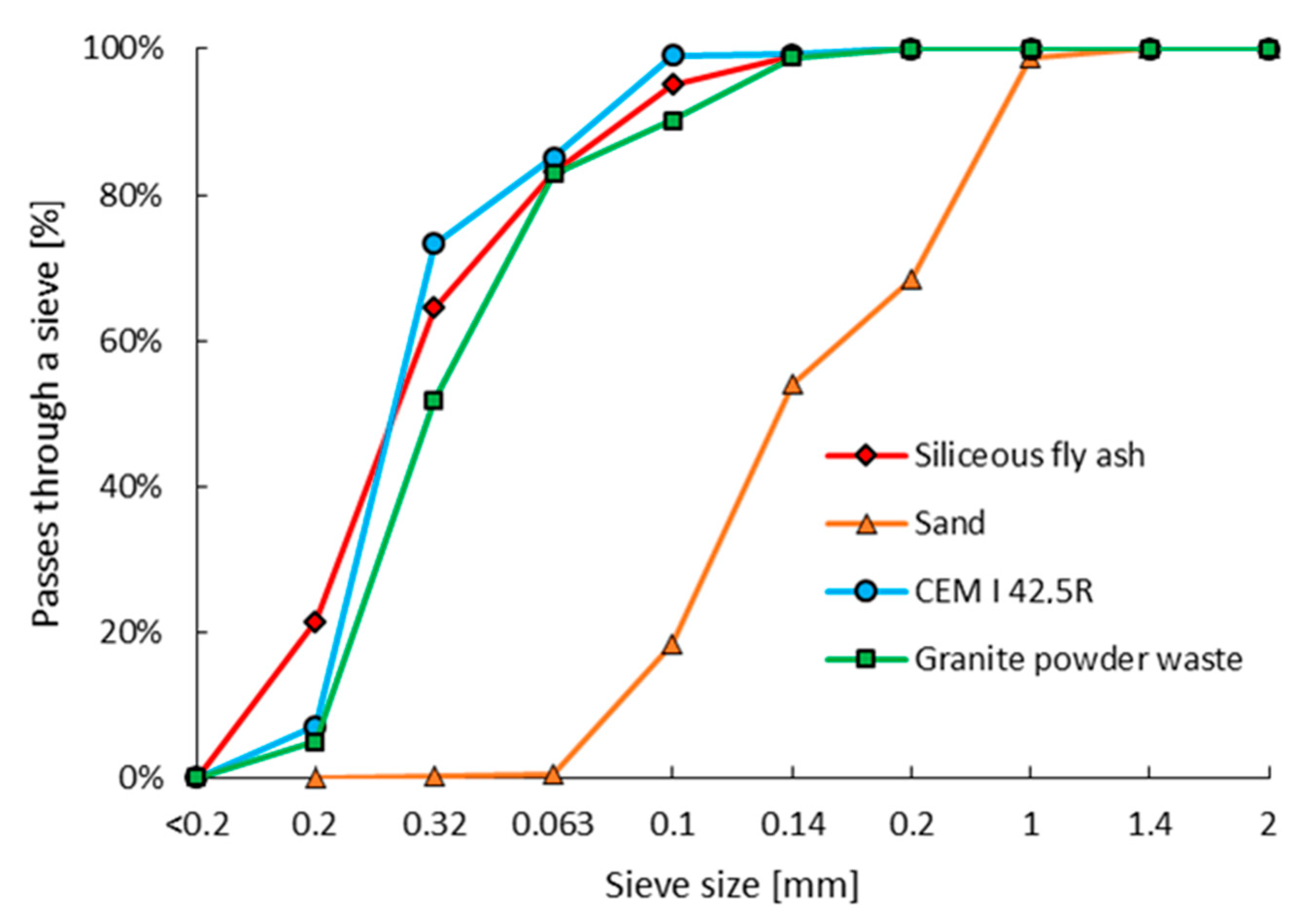
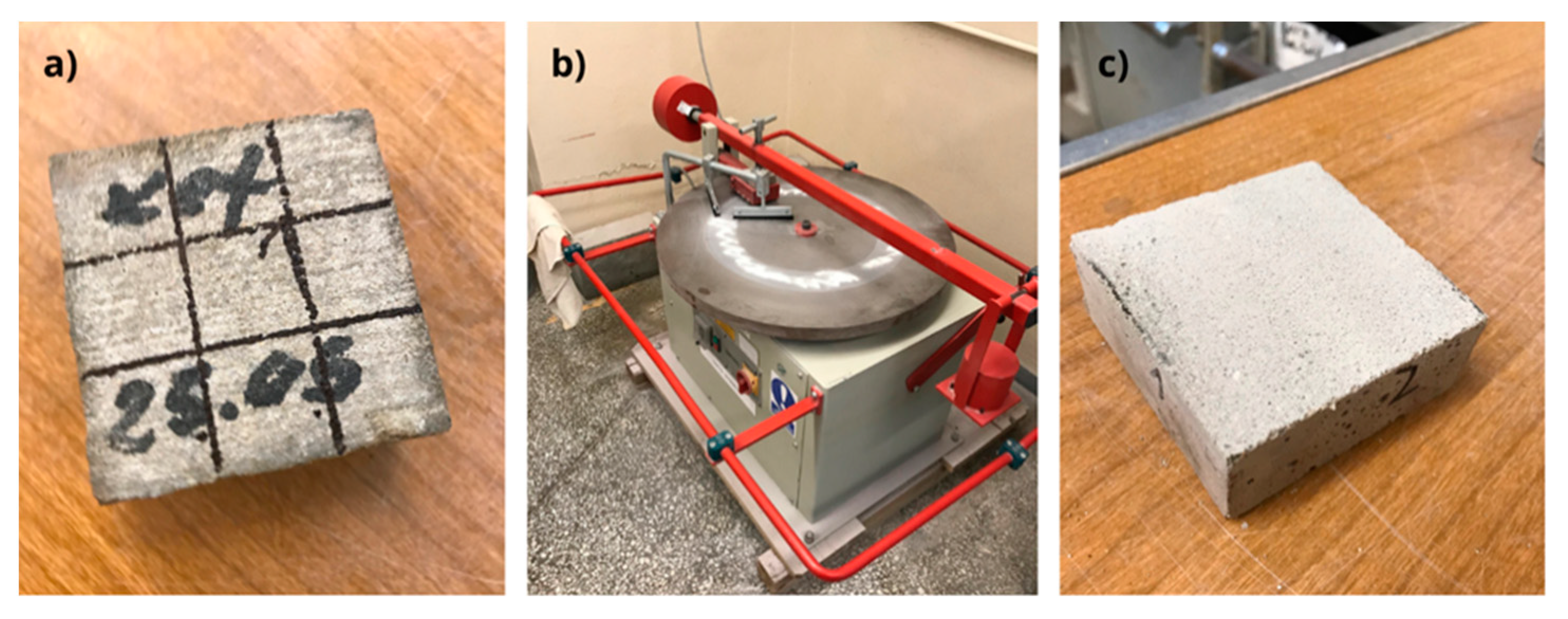

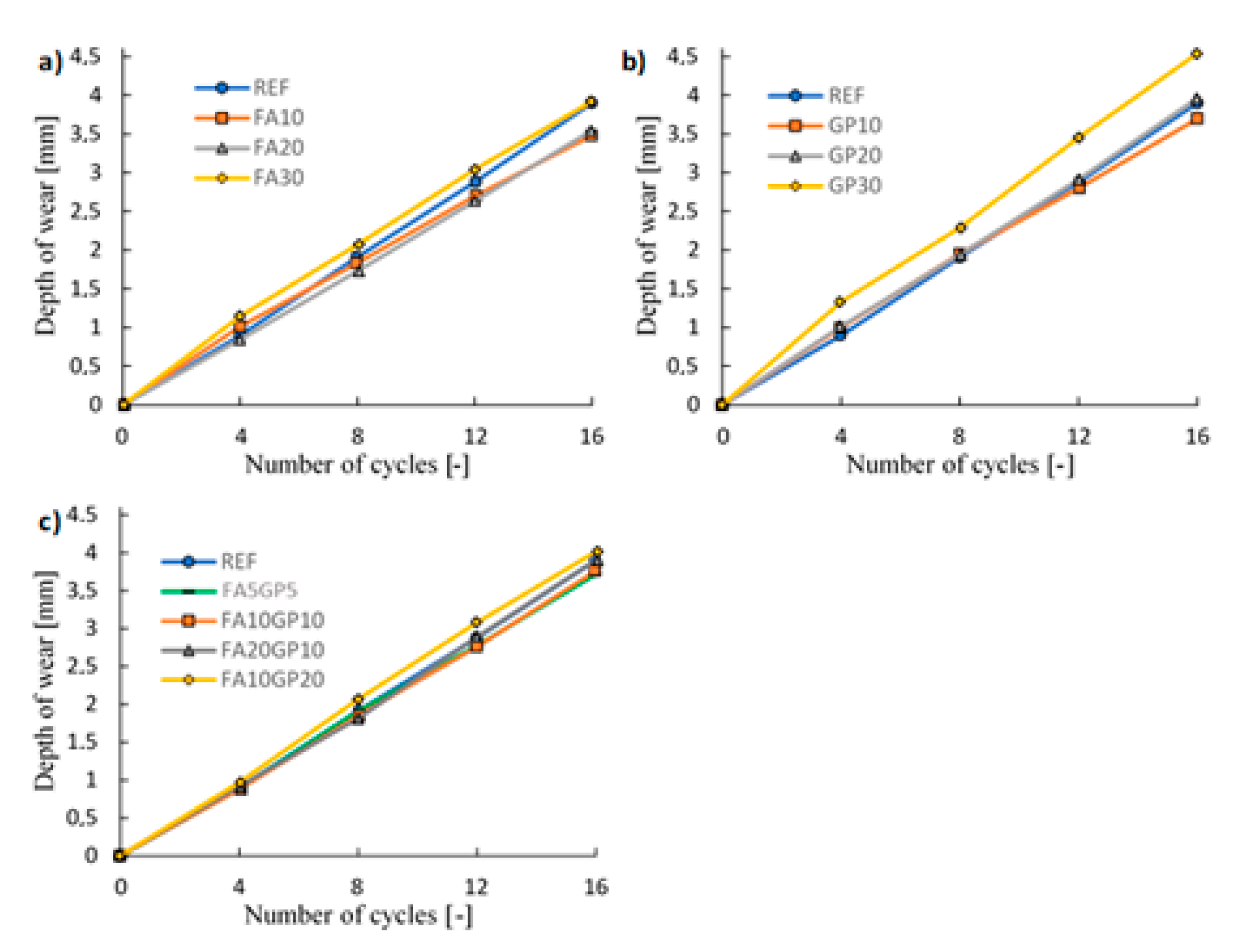

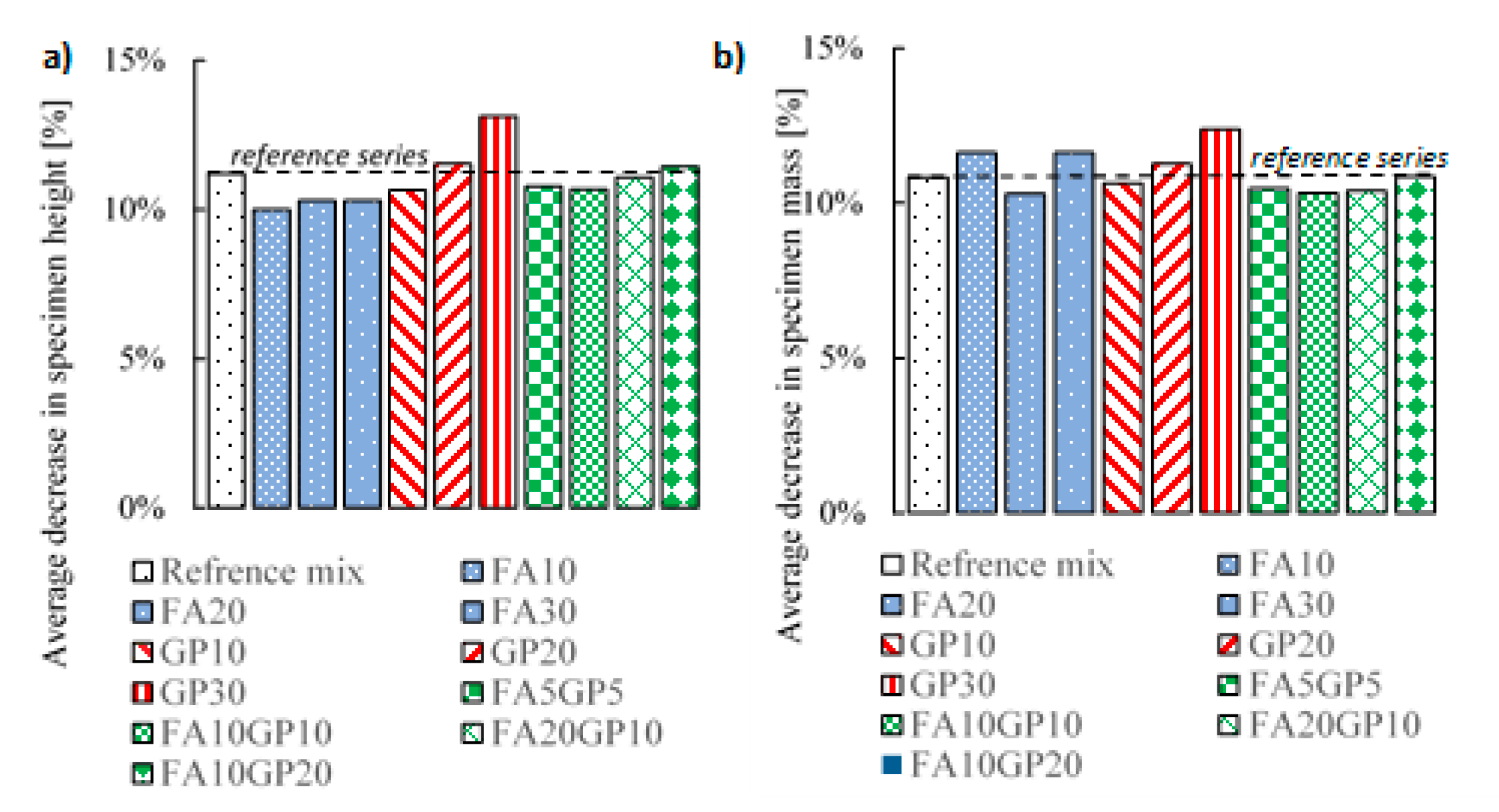
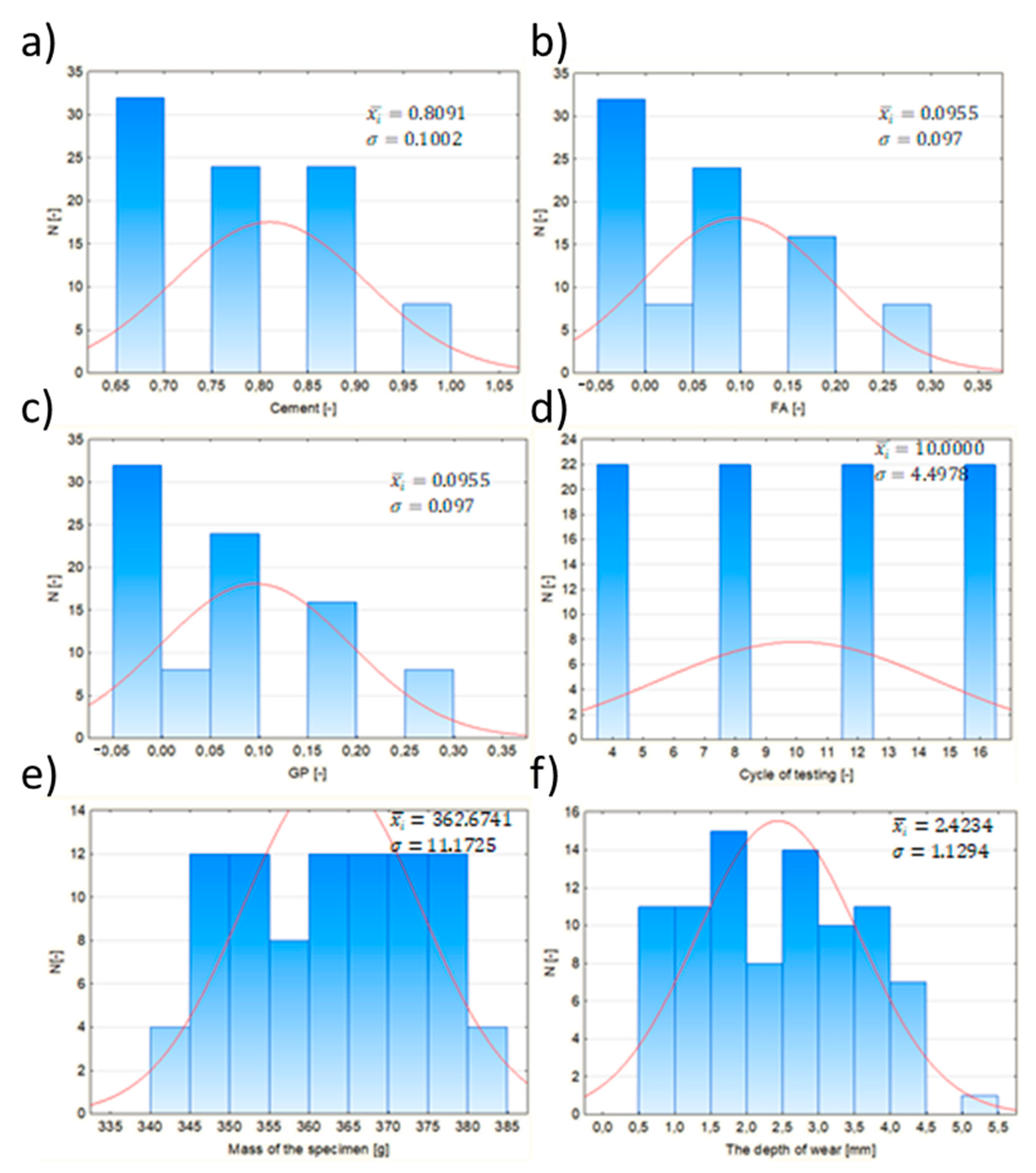
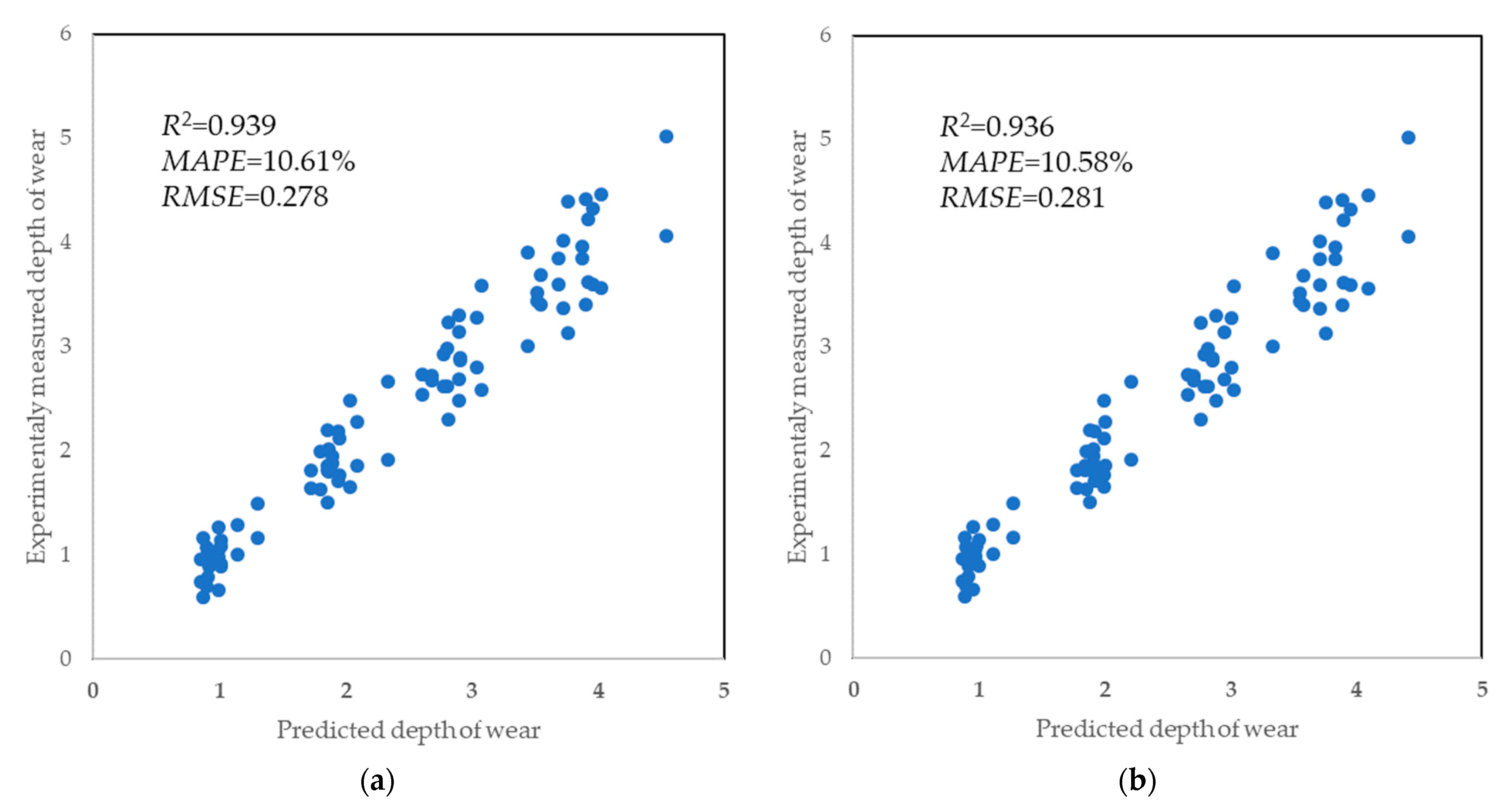
| No. | Series | Cement | Water | w/c | w/b | FA | GP | Binder | Sand |
|---|---|---|---|---|---|---|---|---|---|
| 1 | Ref | 1 | 0.5 | 0.50 | 0.50 | 0 | 0 | 1 | 3 |
| 2 | FA10 | 0.9 | 0.5 | 0.56 | 0.50 | 0.1 | 0 | 1 | 3 |
| 3 | FA20 | 0.8 | 0.5 | 0.63 | 0.50 | 0.2 | 0 | 1 | 3 |
| 4 | FA30 | 0.7 | 0.5 | 0.71 | 0.50 | 0.3 | 0 | 1 | 3 |
| 5 | GP10 | 0.9 | 0.5 | 0.56 | 0.50 | 0 | 0.1 | 1 | 3 |
| 6 | GP20 | 0.8 | 0.5 | 0.63 | 0.50 | 0 | 0.2 | 1 | 3 |
| 7 | GP30 | 0.7 | 0.5 | 0.71 | 0.50 | 0 | 0.3 | 1 | 3 |
| 8 | 5FA + 5GP | 0.9 | 0.5 | 0.56 | 0.50 | 0.05 | 0.05 | 1 | 3 |
| 9 | 10FA + 10GP | 0.8 | 0.5 | 0.63 | 0.50 | 0.1 | 0.1 | 1 | 3 |
| 10 | 20FA + 10GP | 0.7 | 0.5 | 0.71 | 0.50 | 0.2 | 0.1 | 1 | 3 |
| 11 | 10FA + 20GP | 0.7 | 0.5 | 0.71 | 0.50 | 0.1 | 0.2 | 1 | 3 |
| Number of Inputs | Number of Hidden Layers | Number of Hidden Neurons | Activation Functions | Learning Algorithms |
|---|---|---|---|---|
| From 1 to 5 | 1 or 2 | From 1 to 20 | Linear Sinus Tanh Logistic Exponential | Quasi-Newton Levenberg–Marquardt, Conjugate Gradient |
| Variants of Inputs | Number of Trees | Minimum Splitting Subset | Minimum Number of Instances in Leaves |
|---|---|---|---|
| From 1 to 5 | Up to 500 | 5 | 2 |
| No. | Series | Cement [-] | Fly Ash [-] | Granite Powder [-] | Number of Cycles | Mass of the Sample [g] | Depth of Wear [mm] |
|---|---|---|---|---|---|---|---|
| 1 | REF | 1 | 0 | 0 | 4 | 356.56 | 0.79 |
| 2 | REF | 1 | 0 | 0 | 4 | 373.21 | 1.00 |
| 3 | FA10 | 0.9 | 0.1 | 0 | 4 | 362.15 | 0.98 |
| 4 | FA10 | 0.9 | 0.1 | 0 | 4 | 354.24 | 1.05 |
| 5 | FA20 | 0.8 | 0.2 | 0 | 4 | 370.63 | 0.74 |
| 6 | FA20 | 0.8 | 0.2 | 0 | 4 | 357.84 | 0.95 |
| 7 | FA30 | 0.7 | 0.3 | 0 | 4 | 362.15 | 1.01 |
| 8 | FA30 | 0.7 | 0.3 | 0 | 4 | 354.24 | 1.29 |
| 9 | GP10 | 0.9 | 0 | 0.1 | 4 | 378.54 | 1.08 |
| 10 | GP10 | 0.9 | 0 | 0.1 | 4 | 345.97 | 0.92 |
| 11 | GP20 | 0.8 | 0 | 0.2 | 4 | 368.28 | 0.89 |
| 12 | GP20 | 0.8 | 0 | 0.2 | 4 | 345.82 | 1.14 |
| 13 | GP30 | 0.7 | 0 | 0.3 | 4 | 366.04 | 1.16 |
| 14 | GP30 | 0.7 | 0 | 0.3 | 4 | 343.56 | 1.50 |
| 15 | FA5GP5 | 0.9 | 0.05 | 0.05 | 4 | 380.16 | 1.08 |
| 16 | FA5GP5 | 0.9 | 0.05 | 0.05 | 4 | 349.8 | 0.70 |
| 17 | FA10GP10 | 0.8 | 0.1 | 0.1 | 4 | 373.29 | 0.60 |
| 18 | FA10GP10 | 0.8 | 0.1 | 0.1 | 4 | 365.79 | 1.16 |
| 19 | FA20GP10 | 0.7 | 0.2 | 0.1 | 4 | 375.29 | 0.94 |
| 20 | FA20GP10 | 0.7 | 0.2 | 0.1 | 4 | 361.13 | 0.89 |
| 21 | FA10GP20 | 0.7 | 0.1 | 0.2 | 4 | 379.72 | 0.66 |
| 22 | FA10GP20 | 0.7 | 0.1 | 0.2 | 4 | 354.42 | 1.27 |
| 23 | REF | 1 | 0 | 0 | 8 | 356.56 | 1.87 |
| 24 | REF | 1 | 0 | 0 | 8 | 373.21 | 1.94 |
| 25 | FA10 | 0.9 | 0.1 | 0 | 8 | 362.15 | 1.81 |
| 26 | FA10 | 0.9 | 0.1 | 0 | 8 | 354.24 | 1.86 |
| 27 | FA20 | 0.8 | 0.2 | 0 | 8 | 370.63 | 1.64 |
| 28 | FA20 | 0.8 | 0.2 | 0 | 8 | 357.84 | 1.81 |
| 29 | FA30 | 0.7 | 0.3 | 0 | 8 | 362.15 | 1.86 |
| 30 | FA30 | 0.7 | 0.3 | 0 | 8 | 354.24 | 2.28 |
| 31 | GP10 | 0.9 | 0 | 0.1 | 8 | 378.54 | 2.19 |
| 32 | GP10 | 0.9 | 0 | 0.1 | 8 | 345.97 | 1.71 |
| 33 | GP20 | 0.8 | 0 | 0.2 | 8 | 368.28 | 1.77 |
| 34 | GP20 | 0.8 | 0 | 0.2 | 8 | 345.82 | 2.12 |
| 35 | GP30 | 0.7 | 0 | 0.3 | 8 | 366.04 | 1.91 |
| 36 | GP30 | 0.7 | 0 | 0.3 | 8 | 343.56 | 2.67 |
| 37 | FA5GP5 | 0.9 | 0.05 | 0.05 | 8 | 380.16 | 2.01 |
| 38 | FA5GP5 | 0.9 | 0.05 | 0.05 | 8 | 349.8 | 1.80 |
| 39 | FA10GP10 | 0.8 | 0.1 | 0.1 | 8 | 373.29 | 1.50 |
| 40 | FA10GP10 | 0.8 | 0.1 | 0.1 | 8 | 365.79 | 2.20 |
| 41 | FA20GP10 | 0.7 | 0.2 | 0.1 | 8 | 375.29 | 2.00 |
| 42 | FA20GP10 | 0.7 | 0.2 | 0.1 | 8 | 361.13 | 1.63 |
| 43 | FA10GP20 | 0.7 | 0.1 | 0.2 | 8 | 379.72 | 1.65 |
| 44 | FA10GP20 | 0.7 | 0.1 | 0.2 | 8 | 354.42 | 2.48 |
| 45 | REF | 1 | 0 | 0 | 12 | 356.56 | 2.89 |
| 46 | REF | 1 | 0 | 0 | 12 | 373.21 | 2.86 |
| 47 | FA10 | 0.9 | 0.1 | 0 | 12 | 362.15 | 2.72 |
| 48 | FA10 | 0.9 | 0.1 | 0 | 12 | 354.24 | 2.67 |
| 49 | FA20 | 0.8 | 0.2 | 0 | 12 | 370.63 | 2.54 |
| 50 | FA20 | 0.8 | 0.2 | 0 | 12 | 357.84 | 2.73 |
| 51 | FA30 | 0.7 | 0.3 | 0 | 12 | 362.15 | 2.80 |
| 52 | FA30 | 0.7 | 0.3 | 0 | 12 | 354.24 | 3.28 |
| 53 | GP10 | 0.9 | 0 | 0.1 | 12 | 378.54 | 2.98 |
| 54 | GP10 | 0.9 | 0 | 0.1 | 12 | 345.97 | 2.62 |
| 55 | GP20 | 0.8 | 0 | 0.2 | 12 | 368.28 | 2.69 |
| 56 | GP20 | 0.8 | 0 | 0.2 | 12 | 345.82 | 3.14 |
| 57 | GP30 | 0.7 | 0 | 0.3 | 12 | 366.04 | 3.01 |
| 58 | GP30 | 0.7 | 0 | 0.3 | 12 | 343.56 | 3.90 |
| 59 | FA5GP5 | 0.9 | 0.05 | 0.05 | 12 | 380.16 | 2.93 |
| 60 | FA5GP5 | 0.9 | 0.05 | 0.05 | 12 | 349.8 | 2.62 |
| 61 | FA10GP10 | 0.8 | 0.1 | 0.1 | 12 | 373.29 | 2.30 |
| 62 | FA10GP10 | 0.8 | 0.1 | 0.1 | 12 | 365.79 | 3.23 |
| 63 | FA20GP10 | 0.7 | 0.2 | 0.1 | 12 | 375.29 | 3.31 |
| 64 | FA20GP10 | 0.7 | 0.2 | 0.1 | 12 | 361.13 | 2.48 |
| 65 | FA10GP20 | 0.7 | 0.1 | 0.2 | 12 | 379.72 | 2.58 |
| 66 | FA10GP20 | 0.7 | 0.1 | 0.2 | 12 | 354.42 | 3.58 |
| 67 | REF | 1 | 0 | 0 | 16 | 356.56 | 3.96 |
| 68 | REF | 1 | 0 | 0 | 16 | 373.21 | 3.84 |
| 69 | FA10 | 0.9 | 0.1 | 0 | 16 | 362.15 | 3.52 |
| 70 | FA10 | 0.9 | 0.1 | 0 | 16 | 354.24 | 3.44 |
| 71 | FA20 | 0.8 | 0.2 | 0 | 16 | 370.63 | 3.41 |
| 72 | FA20 | 0.8 | 0.2 | 0 | 16 | 357.84 | 3.68 |
| 73 | FA30 | 0.7 | 0.3 | 0 | 16 | 362.15 | 3.62 |
| 74 | FA30 | 0.7 | 0.3 | 0 | 16 | 354.24 | 4.22 |
| 75 | GP10 | 0.9 | 0 | 0.1 | 16 | 378.54 | 4.02 |
| 76 | GP10 | 0.9 | 0 | 0.1 | 16 | 345.97 | 3.37 |
| 77 | GP20 | 0.8 | 0 | 0.2 | 16 | 368.28 | 3.60 |
| 78 | GP20 | 0.8 | 0 | 0.2 | 16 | 345.82 | 4.32 |
| 79 | GP30 | 0.7 | 0 | 0.3 | 16 | 366.04 | 4.06 |
| 80 | GP30 | 0.7 | 0 | 0.3 | 16 | 343.56 | 5.02 |
| 81 | FA5GP5 | 0.9 | 0.05 | 0.05 | 16 | 380.16 | 3.84 |
| 82 | FA5GP5 | 0.9 | 0.05 | 0.05 | 16 | 349.8 | 3.60 |
| 83 | FA10GP10 | 0.8 | 0.1 | 0.1 | 16 | 373.29 | 3.13 |
| 84 | FA10GP10 | 0.8 | 0.1 | 0.1 | 16 | 365.79 | 4.40 |
| 85 | FA20GP10 | 0.7 | 0.2 | 0.1 | 16 | 375.29 | 4.41 |
| 86 | FA20GP10 | 0.7 | 0.2 | 0.1 | 16 | 361.13 | 3.40 |
| 87 | FA10GP20 | 0.7 | 0.1 | 0.2 | 16 | 379.72 | 3.57 |
| 88 | FA10GP20 | 0.7 | 0.1 | 0.2 | 16 | 354.42 | 4.47 |
| Parameter | W [-] | α [-] | Alpha Level [-] |
|---|---|---|---|
| Cement | 0.8431 | 0.01 | 0.955 |
| Fly ash | 0.8363 | 0.01 | 0.955 |
| Granite powder | 0.8363 | 0.01 | 0.955 |
| Cycle of testing | 0.8558 | 0.01 | 0.955 |
| Mas of the specimen | 0.9471 | 0.01 | 0.955 |
| The depth of wear | 0.9620 | 0.01 | 0.955 |
Disclaimer/Publisher’s Note: The statements, opinions and data contained in all publications are solely those of the individual author(s) and contributor(s) and not of MDPI and/or the editor(s). MDPI and/or the editor(s) disclaim responsibility for any injury to people or property resulting from any ideas, methods, instructions or products referred to in the content. |
© 2023 by the authors. Licensee MDPI, Basel, Switzerland. This article is an open access article distributed under the terms and conditions of the Creative Commons Attribution (CC BY) license (https://creativecommons.org/licenses/by/4.0/).
Share and Cite
Czarnecki, S.; Chajec, A.; Malazdrewicz, S.; Sadowski, L. The Prediction of Abrasion Resistance of Mortars Modified with Granite Powder and Fly Ash Using Artificial Neural Networks. Appl. Sci. 2023, 13, 4011. https://doi.org/10.3390/app13064011
Czarnecki S, Chajec A, Malazdrewicz S, Sadowski L. The Prediction of Abrasion Resistance of Mortars Modified with Granite Powder and Fly Ash Using Artificial Neural Networks. Applied Sciences. 2023; 13(6):4011. https://doi.org/10.3390/app13064011
Chicago/Turabian StyleCzarnecki, Slawomir, Adrian Chajec, Seweryn Malazdrewicz, and Lukasz Sadowski. 2023. "The Prediction of Abrasion Resistance of Mortars Modified with Granite Powder and Fly Ash Using Artificial Neural Networks" Applied Sciences 13, no. 6: 4011. https://doi.org/10.3390/app13064011
APA StyleCzarnecki, S., Chajec, A., Malazdrewicz, S., & Sadowski, L. (2023). The Prediction of Abrasion Resistance of Mortars Modified with Granite Powder and Fly Ash Using Artificial Neural Networks. Applied Sciences, 13(6), 4011. https://doi.org/10.3390/app13064011










